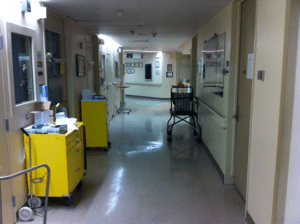Written by: Paul Pavao
The most important thing I can tell you is that Blastic Plasmacytoid Dendritic Cell Neoplasm (BPDCN) can be survived. As of 2019 survival requires a bone marrow transplant, but it can be survived.
I am not necessarily a perfect case. There are two “markers” for BPDCN. I had both of them, but not on the same cells together. I also had the symptoms of BPDCN. Tumors on the skin came first, and leukemia symptoms come afterward. I also had a marker for ALL (Acute Lymphocytic Leukemia). This was extremely unusual. The first laboratory diagnosed me with BPDCN, but Vanderbilt Cancer Center changed the diagnosis to Acute Undifferentiated Leukemia.
 Nonetheless, I was treated as a BPDCN patient. Treatment began in July, 2011. To the left, you can see my wife and I during early chemo.
Nonetheless, I was treated as a BPDCN patient. Treatment began in July, 2011. To the left, you can see my wife and I during early chemo.
The idea was to use AML (Acute Myeloid Leukemia) chemo, add in one extra drug to address the ALL, get the chemo over rapidly, and get me a bone marrow transplant. Despite a major setback three months in that delayed the transplant for two months, that plan was executed, and I survived.
Because I blogged through my entire experience, I became a contact point for BPDCN patients. I have corresponded with at least fifteen or twenty persons who were diagnosed.
One Irish man went through BPDCN treatment before me. He found me because of my blog as well. He emailed me regularly through all my treatment. I received severe chemo and all the radiation the hospital was allowed to give me. Nonetheless, my Irish friend had more severe treatment. He got four rounds of chemo, then they took some of his own marrow, then they gave him four more rounds. His bone marrow transplant after the eight rounds was from his own marrow (“autologous transplant”). The chemo was so severe that he could not walk a mile even two years later, but he survived and is surviving.
More recently, the test drug SL-401 (now tagraxofusp or Elzonris) has been successfully used on BPDCN patients. Two young ladies that contacted me on Facebook in 2017. Both were treated with SL-401. Both went through very little side effects, nothing like the chemo I endured, but both received a transplant. Unfortunately, one of them relapsed and died earlier this year. The other, though, is thriving.
The danger with BPDCN is relapse. For some unknown reason, a BPDCN relapse typically cannot be put in remission a second time. I hope things have changed, but that was the case when I was reading all the studies back in 2011.
That said, it seemed to me that a good half of the people who have contacted me have survived. This is wonderful because when I was diagnosed, word was that no one survived.
I have to admit that this terrified me. The words I remember the most from my internet reading was, “The prognosis … is generally poor with a median survival of 14 months. The treatment is conventional chemotherapy for AML, which generally shows a good initial response followed by quick and fatal relapse.”
Breathtaking words! You won’t find them on the internet anymore except on my blog because the site they were on let me change the description. After beginning to use bone marrow transplants as treatment before relapse could occur, BPDCN sufferers were regularly surviving.
Again, the really fortunate thing is that they do not have to go through the kind of chemo that I and my Irish friend went through. SL-401 is much more mild, yet it is getting survival rates as good as the strong chemo that saved my life. Of course, the marrow transplant is as difficult for BPDCN patients who received SL-401 as it was for me. My nurses did not sugarcoat the marrow transplant for me, so I won’t sugarcoat it for you. As one nurse told me, “If you thought chemo kicked your butt, this transplant will be twice as bad.” Yikes!

I named the nurse in this photo “Kamau,” which is Swahili for “quiet warrior.” This was my first chemo being introduced.
 Nonetheless, I survived! I not only survived, I thrived, and I went through the rigors of my treatment with joy. I walked 50 miles in 35 days during my first chemo. The square hallway on our floor was labeled as 26 laps per mile (pictured on the right). I tried to walk 2 miles per day, but hemorrhoid difficulties slowed me down during the height of chemo. I was careful to keep a positive attitude. This was not hard, as I am a Bible teacher. I knew deep down in my soul that “all things work together for good for those who love God and are called according to his purpose” (Rom. 8:28).
Nonetheless, I survived! I not only survived, I thrived, and I went through the rigors of my treatment with joy. I walked 50 miles in 35 days during my first chemo. The square hallway on our floor was labeled as 26 laps per mile (pictured on the right). I tried to walk 2 miles per day, but hemorrhoid difficulties slowed me down during the height of chemo. I was careful to keep a positive attitude. This was not hard, as I am a Bible teacher. I knew deep down in my soul that “all things work together for good for those who love God and are called according to his purpose” (Rom. 8:28).


